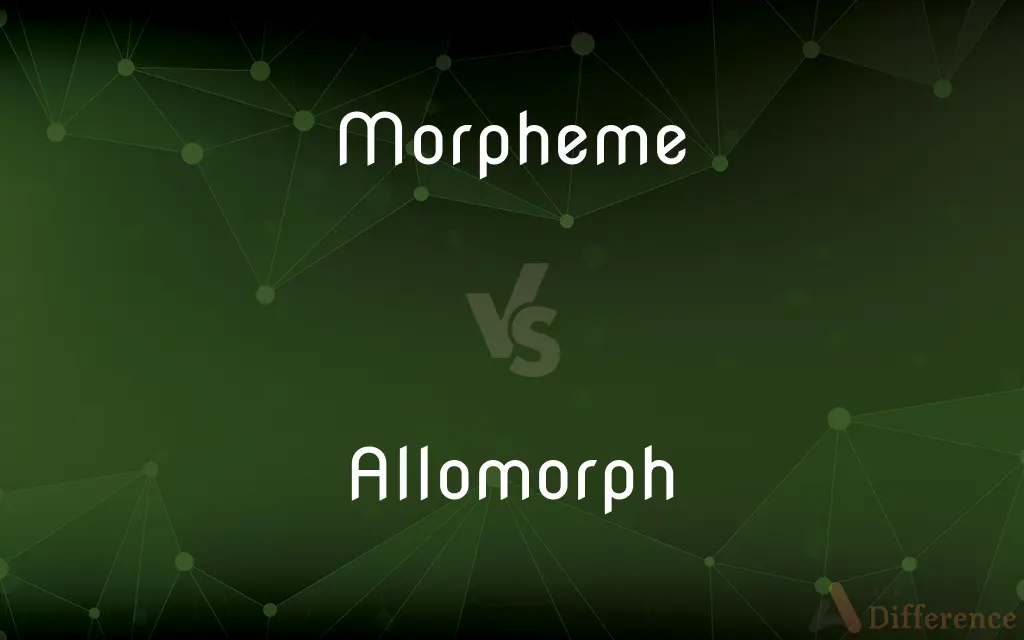Morpheme vs. Allomorph — What's the Difference?
By Fiza Rafique & Urooj Arif — Updated on March 13, 2024
A morpheme is the smallest grammatical unit in a language that carries meaning, while an allomorph is a variant form of a morpheme that arises due to phonological or morphological conditions.

Difference Between Morpheme and Allomorph
Table of Contents
ADVERTISEMENT
Key Differences
A morpheme is the minimal unit of meaning or grammatical function in a language. Morphemes include roots, prefixes, and suffixes, which cannot be divided into smaller parts without losing or altering their meaning. For instance, the word "unhappiness" consists of three morphemes: "un-", "happy", and "-ness". On the other hand, an allomorph represents one of several variant forms of a morpheme that changes its pronunciation but not its meaning, depending on specific linguistic conditions. For example, the indefinite article in English has two allomorphs, "a" and "an", used based on the following word's initial sound.
Morphemes are foundational to understanding the structure and formation of words within a language, highlighting how meaning is constructed and conveyed. Allomorphs, conversely, demonstrate the flexibility and adaptability of language, showing that while the essence of a morpheme remains constant, its phonetic expression can vary to fit linguistic contexts.
The study of morphemes involves identifying and analyzing the way in which they can combine to form words, focusing on their syntactic roles and meanings. The examination of allomorphs, however, delves into phonological rules and the conditions under which morphemes alter their form without changing their inherent meaning, illustrating the dynamic nature of linguistic expression.
Understanding the difference between morphemes and allomorphs is crucial for linguistics because it sheds light on the complexity of word formation and the nuanced ways in which languages operate to maintain clarity, coherence, and auditory aesthetics. Morphemes provide the building blocks of words, while allomorphs ensure these blocks fit together in ways that are phonologically appropriate for the language.
This distinction is not just of academic interest; it has practical implications in language learning, teaching, and linguistic analysis, offering insights into the mechanics of language that are fundamental for effective communication. Through the lens of morphemes and allomorphs, we gain a deeper appreciation of the intricacies of language structure and its capacity to evolve and adapt.
ADVERTISEMENT
Comparison Chart
Definition
The smallest grammatical unit with meaning.
A variant form of a morpheme due to linguistic conditions.
Function
Conveys meaning or grammatical function.
Demonstrates phonological adaptation without altering meaning.
Types
Root, prefix, suffix.
Variants of the same morpheme, e.g., "a" and "an".
Role in Language
Building blocks of words.
Adapt morphemes to fit phonological contexts.
Importance
Fundamental for word formation and syntax.
Highlights flexibility and adaptability in language.
Compare with Definitions
Morpheme
Building blocks for constructing words.
Adding -er to teach forms teacher.
Allomorph
Variant forms of a morpheme.
The plural -s in cats vs. the -es in dishes.
Morpheme
A minimal unit of meaning in a language.
The word cats has two morphemes: cat and -s.
Allomorph
Changes in morpheme form without meaning alteration.
A and an are allomorphs of the indefinite article.
Morpheme
Units that contribute to a word's meaning.
The suffix -ness in happiness denotes a state of being.
Allomorph
Demonstrates linguistic adaptability.
The past tense morpheme -ed has allomorphs as in walked vs. led.
Morpheme
The smallest syntactic element that carries semantic content.
Re- in redo implies doing again.
Allomorph
Examples of language's phonetic variation.
Different pronunciations of the past tense -ed in hoped, added, and wanted.
Morpheme
Irreducible grammatical units within words.
Unbreakable consists of un-, break, and -able.
Allomorph
Reflects phonological conditions in language.
The use of an before vowels.
Morpheme
A morpheme is the smallest meaningful lexical item in a language. A morpheme is not necessarily the same as a word.
Allomorph
In linguistics, an allomorph is a variant phonetic form of a morpheme, or, a unit of meaning that varies in sound and spelling without changing the meaning. The term allomorph describes the realization of phonological variations for a specific morpheme.
Morpheme
A meaningful linguistic unit that cannot be divided into smaller meaningful parts. The word man and the suffix -ed (as in walked) are morphemes.
Allomorph
See paramorph.
Morpheme
(linguistic morphology) The smallest linguistic unit within a word that can carry a meaning.
Allomorph
Any of the variant forms of a morpheme. For example, the phonetic (s) of cats (kăts), (z) of pigs (pĭgz), and (ĭz) horses (hôrsĭz) are allomorphs of the English plural morpheme.
Morpheme
The smallest unit of meaning of a language, which cannot be divided into smaller parts carrying meaning; it is usually smaller than a single wordform, such as the -ed morpheme of verbs in the past tense or the -s morpheme of nouns in the plural form.
Allomorph
(chemistry) Any of the different crystalline forms of a substance.
Morpheme
Minimal meaningful language unit; it cannot be divided into smaller meaningful units
Allomorph
(linguistics) Any of the different phonological representations of a morpheme.
Allomorph
Any one of two or more distinct crystalline forms of the same substance; or the substance having such forms; - as, carbonate of lime occurs in the allomorphs calcite and aragonite.
Allomorph
Any of several different crystalline forms of the same chemical compound;
Calcium carbonate occurs in the allomorphs calcite and aragonite
Allomorph
A variant phonological representation of a morpheme;
The final sounds of `bets' and `beds' and `horses' and `oxen' are allomorphs of the English plural morpheme
Common Curiosities
What is an allomorph?
An allomorph is one of several variant forms of a morpheme that changes its appearance or sound under specific conditions without altering its meaning.
What is a morpheme?
A morpheme is the smallest unit in a language that carries meaning or serves a grammatical function.
Are allomorphs interchangeable?
Allomorphs are not arbitrarily interchangeable; their use depends on specific linguistic rules or conditions.
What role do allomorphs play in language?
Allomorphs ensure that morphemes fit into their phonological context, maintaining the fluidity and coherence of speech.
Why is understanding morphemes important?
Understanding morphemes helps in comprehending word formation, meaning, and the structure of language.
What is the significance of allomorphs in linguistics?
Allomorphs illustrate the dynamic nature of language and how it adapts to phonological rules and conditions.
How does understanding allomorphs benefit language learners?
It helps language learners understand variations in word formation and pronunciation, aiding in more accurate and natural language use.
Can a word have more than one morpheme?
Yes, words can be composed of multiple morphemes, such as roots and affixes.
How do allomorphs arise?
Allomorphs arise due to phonological, morphological, or dialectal conditions that affect the morpheme's pronunciation or appearance.
How do morphemes differ from words?
Morphemes may be words on their own or parts of words, representing the smallest units of meaning, whereas words are complete units of meaning that can stand alone in speech or writing.
Can the same morpheme have different allomorphs?
Yes, the same morpheme can have different allomorphs depending on linguistic conditions.
Are prefixes and suffixes morphemes?
Yes, prefixes and suffixes are types of morphemes known as affixes.
What distinguishes a morpheme from a syllable?
A morpheme carries meaning or grammatical function, whereas a syllable is a unit of sound consisting of a vowel sound or a vowel and consonant sounds, not necessarily carrying meaning.
How are morphemes identified?
Morphemes are identified by their ability to convey meaning independently or when attached to other morphemes.
Can morphemes be standalone words?
Some morphemes, known as free morphemes, can stand alone as words, while others must be attached to other morphemes.
Share Your Discovery

Previous Comparison
Graduate vs. Intern
Next Comparison
Associate vs. ExecutiveAuthor Spotlight
Written by
Fiza RafiqueFiza Rafique is a skilled content writer at AskDifference.com, where she meticulously refines and enhances written pieces. Drawing from her vast editorial expertise, Fiza ensures clarity, accuracy, and precision in every article. Passionate about language, she continually seeks to elevate the quality of content for readers worldwide.
Co-written by
Urooj ArifUrooj is a skilled content writer at Ask Difference, known for her exceptional ability to simplify complex topics into engaging and informative content. With a passion for research and a flair for clear, concise writing, she consistently delivers articles that resonate with our diverse audience.
















































